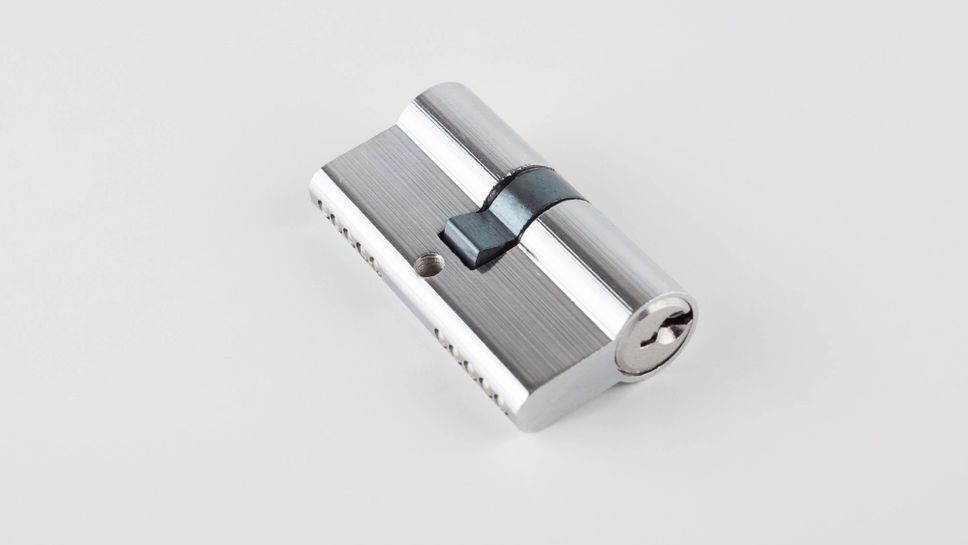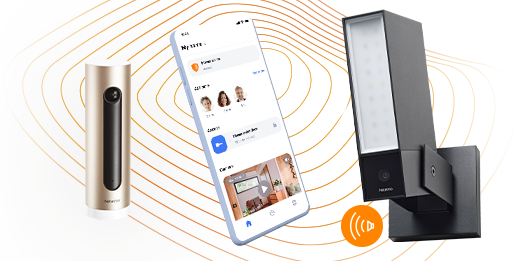Choosing the right cylinder is a crucial step in keeping your front door as secure as possible. Disengageable, knob-operated, pump-operated... Nickel, chrome, brass, platinum... There are so many different products to compare, it can be hard to choose! If you’re looking to change the lock on an external door, read on to find out which type of cylinder will best meet your home security needs.

What’s a cylinder for?
The cylinder is an essential part of a lock, as serves to open and close the door. It generally consists of a metal cylinder into which a key is inserted to activate the locking mechanism.
What are the components of a cylinder?
A lock cylinder (also known as a barrel) is made up of various parts:
- Shell: this is the fixed body of the cylinder.
- Plug: located in the shell, the plug is the moving part of the cylinder into which the key is inserted to lock or unlock the door.
- Pins and drivers: A set of cylindrical pins of different lengths are inserted into holes along the length of the cylinder body. They are arranged at different heights and are the main security component of the lock cylinder. When the right key is inserted in the cylinder, the pins and drivers line up, allowing the locking mechanism to move.
- Springs: Springs are compression components located between the pins and drivers. They maintain constant pressure on the pins, pushing them down into the holes in the cylinder body. The springs contribute to the functionality and strength of the lock cylinder.
- Plugs and screws: The plugs cover the ends of the lock cylinder and can be removed to gain access to the pins and internal mechanism. Screws are used to secure the lock cylinder to the lock case and door.
Bear in mind that the components in a lock cylinder vary according to the type of cylinder (e.g. pin tumbler, disc tumbler, etc.) and the manufacturer. However, the parts described above are generally found in most models.
What are the different types of cylinders?
There are various types to choose from, each with its own specific features and benefits, so let’s take a look at how they compare.
Euro cylinder
- Double Euro cylinder: this is a type of lock cylinder widely used for entrance doors, interior doors and exterior doors. It’s called a “double” cylinder because unlike a single Euro cylinder, it has a lock on both sides of the door. This means you can use a key to open and close the door from both inside and outside. This mechanism is practical because it eliminates the need for an additional door handle on the inside, making it an elegant and compact solution for securing access.
- Euro half-cylinder: A Euro half-cylinder, also known as a single cylinder, is a type of lock cylinder that resembles the standard Euro cylinder, but with one essential difference: it has only one functional side. Unlike the double Euro cylinder, which has a lock on both sides of the door, the Euro half-cylinder is designed for use on one side of the door only. So this type of product is suitable for doors that you only need to open from one side, such as garage doors.
- Thumb turn Euro cylinder: The thumb turn (or thumbturn) Euro cylinder is a special type of lock cylinder with a knob at one end. Unlike standard Euro cylinders, the thumb turn Euro cylinder has a knob so you can open the door quickly and easily from the inside without a key. When you turn the knob clockwise, you activate the locking mechanism, which locks the door. To unlock it, you just turn the knob counter-clockwise.
Pump cylinder
Often used in front door locks. It’s cylindrical in shape with a flat key inserted at the end. A set of pins are arranged along the length of the cylinder, and when you insert the key and turn it, they line up so the door opens.
Disc tumbler
This type of cylinder uses stacked discs which must be correctly aligned by the key to release the locking mechanism. Disc tumblers often offer a higher level of security than pin tumblers.
Disengageable cylinder
A disengageable cylinder is a type of lock cylinder with a special feature that allows the locking mechanism to be manipulated even when the key is already inserted and in the locked position. In other words, it allows the lock to be temporarily deactivated for manual operation without having to turn the key.
Wafer cylinder
This type of cylinder uses moving wafers rather than pins. The wafers are arranged in the cylinder in such a way that only the right key can push them into the correct position, opening the locking mechanism.
Electronic cylinder
These cylinders use electronic components to control the locking mechanism. They can be opened with an electronic key, RFID card, PIN code or even remotely via a wireless connection, avoiding the need for conventional keys.
These cylinder types can vary in terms of security, complexity, compatibility with different types of locks and locking systems. All these factors are likely to affect the price you pay, and don’t forget delivery costs and VAT, too. It’s important to choose the right product for your specific needs in terms of security and functionality.
Which lock cylinder should you choose for optimum front door security?
When choosing a new lock cylinder for your front door, it’s important to consider several factors, including how secure it will be, its level of quality and its compatibility with your existing locking system.
1. Opt for a high-security lock cylinder, as they offer better protection against break-ins. Cylinders are available with features such as:
- Anti-pick pins
- Anti-snap
- Anti-drill driver pins
- Mechanisms to prevent pulling out
2. Check certifications: When buying a new lock cylinder, look for one that’s been tested and certified by recognised security organisations. In Europe, for example, lock cylinders can be certified to EN 1303 standard. This standard guarantees the reliability of a cylinder based on 8 criteria such as endurance, resistance to corrosion and temperature, and resistance to drilling.
The Smart Door Lock meets the most stringent requirements, ensuring the highest level of mechanical and electronic security for your home, in accordance with standard EN15684. It is meticulously crafted to protect you from physical break-in attempts such as picking, drilling, tampering, cutting and forced entry. The cylinder, designed by Netatmo, is made from highly durable stainless steel, reinforced with an anti-drilling pad and 3 security pins for optimum protection.
There’s also A2P (Assurance Prévention Protection) certification, which ensures that the lock, and therefore the cylinder, offers a high level of protection.
3. Ensure compatibility: Check that the lock cylinder you choose is compatible with your front door’s locking system. Measure the length of the existing cylinder and make sure the new cylinder is the right size for your door.
4. Consider a reversible key: Some lock cylinders offer reversible keys, meaning that the key can be inserted into the cylinder either way round. This can be very handy, and avoids the problem of accidentally inserting the key the wrong way round.
5. Consult a professional: If you have any doubts or specific security requirements, it may be a good idea to contact a professional locksmith for advice and recommendations tailored to your specific needs. They should be able to tell you which models are highly rated and what price you can expect to pay. Choosing a highly rated product with advanced features could be well worth it for the extra peace of mind you gain.
It’s important to choose a quality lock cylinder to keep your front door secure. Consider investing in a high-security lock cylinder that meets your specific needs, and make sure you install it correctly to ensure maximum efficiency.




